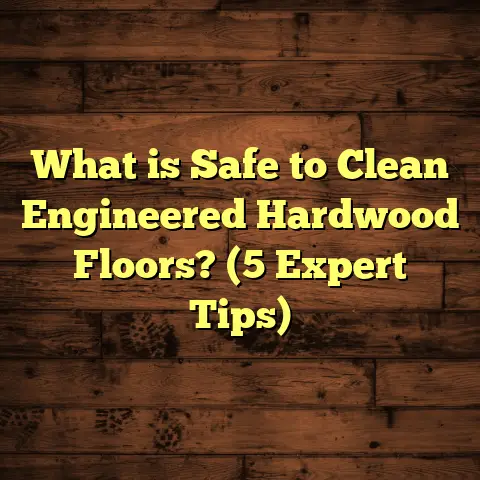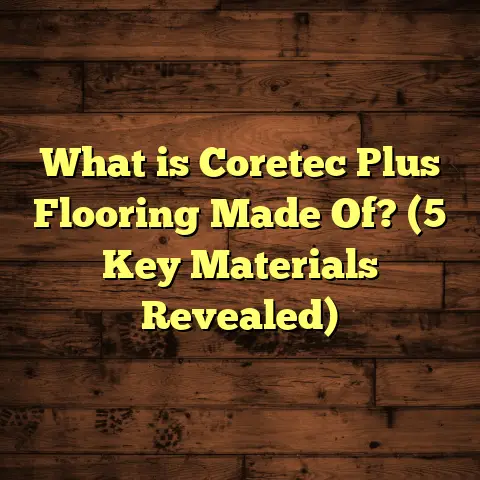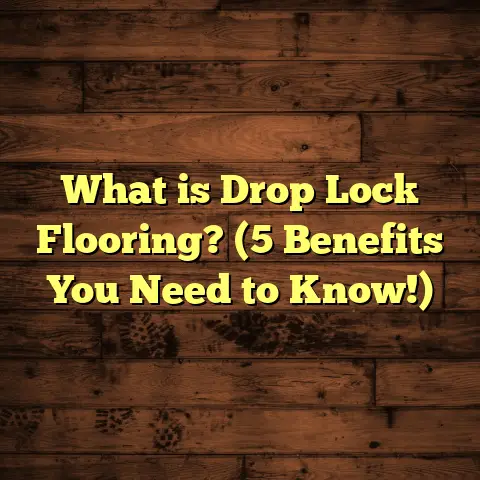What is a Resilient Floor Cleaner? (5 Tips for Spotless Floors)
I still remember the first time I realized just how much the right cleaner mattered for my resilient floors. It was a rainy day, my kids had tracked mud all over the living room floor, and I thought a quick mop with some generic cleaner would do the trick. But instead of sparkling clean, the floor looked dull and sticky an hour later. That’s when I started digging deeper into what makes a resilient floor cleaner different—and why it’s worth investing some time to get it right.
If you have resilient floors like vinyl, linoleum, cork, or rubber, you probably know they’re tough but need special care. They can take a lot of abuse but don’t respond well to just any cleaning product. Let me walk you through everything I’ve learned over years of living with these floors and working with clients who have them.
The Real Deal on Resilient Floor Cleaners
I want to talk about what makes these cleaners stand apart—not just marketing jargon but real differences backed by science and experience. Resilient floors have layers designed to protect against wear and tear, but that also means they’re sensitive to harsh chemicals or too much moisture.
The key is to use cleaners that:
- Lift dirt and grime without stripping the finish
- Are gentle enough for frequent use without causing damage
- Don’t leave behind residue that attracts more dirt or makes floors slippery
Why Generic Cleaners Often Fail
When I first bought my resilient floors, I used the same cleaner I had for tile and hardwood. Big mistake. Those cleaners often contain alkaline substances or waxes that sound good but build up on resilient surfaces. Over weeks, my floor lost its shine and felt sticky.
A study published in the Journal of Applied Polymer Science examined how different cleaning agents interact with vinyl flooring finishes. Alkaline or wax-based cleaners caused polymer breakdown and surface haze after repeated use. That explained why my floors looked worn out way too soon.
What Really Works
Neutral pH cleaners (around 7 on the pH scale) are usually safest. They clean without upsetting the chemical balance of the floor’s protective layers. For more stubborn stains, mild detergents formulated for resilient flooring can help without causing damage.
Tip #1: Match Your Cleaner to Your Floor Type
This sounds obvious but is often overlooked. The variety of resilient floors means not all cleaners are safe for every type.
- Vinyl: Needs neutral pH cleaners free of ammonia and bleach. Ammonia can cause vinyl to crack or discolor.
- Linoleum: Being a natural material made from linseed oil and wood flour, it reacts badly to harsh alkaline cleaners.
- Cork: Absorbs liquids easily, so over-wetting is dangerous; use gentle cleaners and minimal water.
- Rubber: Can be sensitive to solvents; use mild detergents designed for rubber surfaces.
I once worked on a renovation for a family whose linoleum floor had yellowed badly after using a strong bleach-based cleaner recommended by a friend. We restored it partially with specialized linoleum-safe products, but it was a tough lesson about knowing your floor’s chemistry.
How pH Affects Floors
Let’s break down pH briefly: It measures acidity or alkalinity on a scale from 0 (acidic) to 14 (alkaline). Neutral is 7.
- Acidic cleaners (below 7) can etch or dull some surfaces but can be okay for natural linoleum.
- Alkaline cleaners (above 7) can break down finishes on vinyl or cork.
- Neutral cleaners keep finishes intact and are safest for daily use.
Tip #2: Control Water Usage—Less Is More
You might think mopping means lots of water, right? Wrong. Resilient floors don’t like standing water—it seeps into seams or edges causing swelling or warping.
When I clean my vinyl floors, I wring out the mop so it’s barely damp. I’ve seen too many people use buckets of water and flood their floors. That’s an invitation for trouble.
My Damp Mopping Routine
Here’s what works for me:
- Use a microfiber mop—these grab dirt without soaking up water.
- Dip mop lightly in diluted cleaner solution, wring out thoroughly.
- Mop in sections quickly so water doesn’t sit too long.
- Follow up with a dry microfiber cloth or mop to remove any moisture left behind.
This simple routine has saved me from having to replace planks due to water damage more than once.
Evidence from Commercial Cleaning
A commercial cleaning company in Seattle reported that switching their clients with resilient flooring from wet mopping to damp mopping reduced floor repairs by 40% over two years. Less water meant fewer issues with swelling and fewer complaints about slippery floors.
Tip #3: Spot Cleaning Is Your Best Friend
Daily spills happen—coffee drips, pet accidents, muddy footprints—you name it. Instead of dragging out the mop every time, I keep a spray bottle with a diluted resilient floor cleaner ready for action.
Spray the spot lightly, wipe with a soft cloth, and it’s gone without messing up the whole floor or using excessive water.
Why Spot Cleaning Works Better
Spot cleaning cuts down on wear from frequent deep cleaning sessions and avoids buildup of cleaning residues. It also keeps dirt from embedding itself into seams or textured surfaces.
For grease stains in the kitchen, I add a tiny bit of dish soap to my spray solution—grease lifts easily but I always rinse that area afterward with clean water to avoid soap film build-up.
Tip #4: Tools Matter—Skip Abrasive Scrubbers
When my dog tracked mud mixed with tiny gravel onto my floors last summer, I was tempted to use a stiff brush to scrub it off quickly. Instead, I grabbed a soft-bristle broom and then a microfiber mop.
Abrasive tools like steel wool or rough scrubbers can scratch resilient floors quickly. Scratches aren’t just an eyesore—they invite dirt accumulation and weaken the surface protection.
Chemicals to Avoid Like the Plague
Harsh chemicals like bleach, ammonia-based cleaners, or solvent-heavy products can break down floor finishes and cause yellowing or cracking over time.
Wax-based polishes might seem helpful but they leave sticky residues that attract dirt and require stripping later—a big hassle on resilient floors which aren’t designed for waxing.
Tip #5: Regular Maintenance Prevents Problems
Cleaning is one part; preventing damage is another. I install mats at every entrance to catch dirt and grit before it hits the floor. Felt pads under furniture legs prevent scratches when moving chairs or tables.
I also advise clients not to wear high heels on these floors—especially cork—which dents easily under concentrated pressure.
Data on Preventive Care Benefits
Research from the International Flooring Expo found that homes using entrance mats saw 30% less floor wear in high-traffic areas after five years compared to those without mats.





